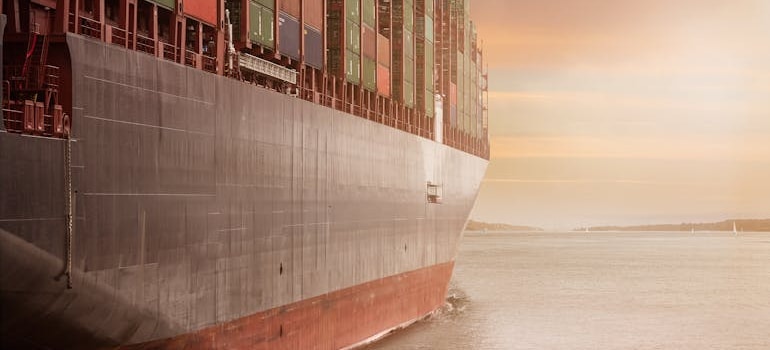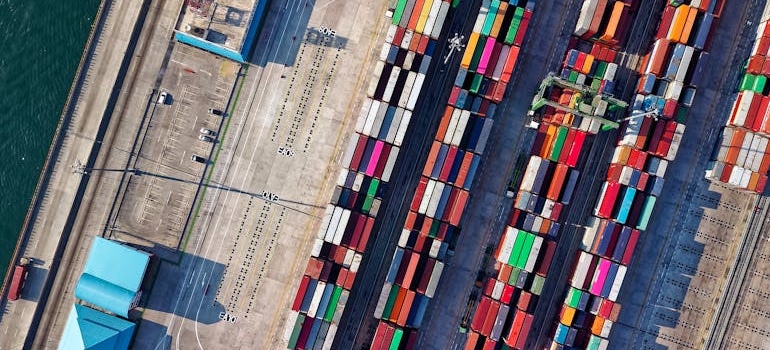Ocean Freight
Trust International Sea & Air Shipping for reliable, efficient sea freight of your household goods, backed by decades of experience.

Get a Free Moving Quote Now!
Start Your International Moving Journey





Moving belongings across international waters can be a complex process, but with the right ocean freight shipping company, it can be simplified. Whether you’re transporting personal items or business goods, sea freight remains one of the most cost-effective methods for moving worldwide. The process involves several steps, from packaging and loading to customs clearance and final delivery, ensuring your items arrive safely at their destination.
International Sea & Air Shipping will show you how ocean freight works, the types of shipping containers available, and tips to make the most of sea freight shipping for your move. Contact us today and let’s get started!

How to Move Personal Belongings Overseas
When moving your belongings internationally, packing and labeling are important to ensure a smooth process. The ocean logistics involved in shipping goods across the globe can be complex, but with the right preparation, it’s manageable.
Packing and Labeling Tips for a Successful International Move
Packing fragile items, furniture, and other belongings requires attention to detail. Make sure to use high-quality packing materials such as bubble wrap, packing paper, and sturdy boxes to protect your items during transit. Label all boxes clearly with both their contents and the destination to avoid confusion or delays. For more fragile items like pianos, it’s recommended to opt for specialized piano shipping services to ensure safe transport. Best practices for packing include:
- Using double-walled boxes for heavy items
- Cushioning fragile goods with packing paper or bubble wrap
- Clearly labeling boxes with content descriptions and destination information
- Grouping small or loose items in sealed bags to avoid misplacement
Key Considerations When Shipping Internationally by Sea
When planning to ship internationally by sea, it’s important to consider several factors that influence timing, cost, and the overall logistics of the move. Unlike air freight, sea freight cargo offers the capacity to ship larger volumes at a lower cost. However, longer transit times, customs clearance, and container types must be factored into your decision.
Timing and Cost
International sea freight shipments typically take longer than air freight, ranging from a few weeks to a few months, depending on the distance between the origin and destination ports. However, this extended timeframe is often offset by the significantly lower costs associated with cargo by sea. When calculating costs, it’s necessary to factor in container type, weight, and destination port fees, as these can vary greatly. The shipping route can also play a significant role in determining the transit time, especially if the cargo passes through busy ports or areas with potential weather-related delays.
Required Documents for International Shipping
Shipping goods internationally involves certain documentation to ensure a smooth process. The key documents required include:
- Bill of Lading (B/L): The legal document between the shipper and carrier that details the shipment.
- Commercial Invoice: This outlines the value of the goods and serves as proof of the transaction.
- Packing List: An inventory of the goods being shipped, essential for customs clearance.
- Certificate of Origin: Required in certain countries to verify the origin of the goods.
By ensuring these documents are prepared in advance, you can avoid unnecessary delays during your shipping process. Each document is important for making sure that your cargo clears customs, both at the port of origin and destination. It’s important to note that incomplete or inaccurate documentation can result in customs delays or additional fees, so working closely with your shipping provider to ensure compliance is necessary.

Insurance and Tracking for Overseas Moves
Securing insurance for your belongings is an important part of the ocean freight shipping process. Marine insurance covers your goods from the moment they leave your home until they arrive at their destination, protecting you from potential damage or loss during transit.
Additionally, most container moving services provide tracking options, allowing you to monitor your shipment’s progress throughout its journey. Keeping track of your goods helps you stay informed and gives you peace of mind, knowing your items are safe throughout the move. Insurance is particularly important if you are shipping high-value items, as it provides an additional layer of financial protection against unforeseen events.
How Do I Move Goods Internationally? Exploring Your Options
When deciding to move goods internationally, choosing the right freight method is the most important part. Sea freight and air freight both have their advantages, but sea freight remains the best option for larger volumes and lower costs.
Choosing the Right Freight Method
While air freight offers faster transit times, it is far more expensive, especially for heavy or bulky items. Sea freight is often the preferred option for large shipments, offering cost-effectiveness, especially for items such as vehicles or furniture. However, if you need to ship smaller, more urgent items, air freight might be worth considering. For example:
- Air Freight: Ideal for smaller, time-sensitive shipments like electronics or documents.
- Sea Freight: Best for large or bulk items such as furniture, vehicles, or commercial goods, where cost savings are more important than speed.
Sea freight is often the preferred option for large shipments, offering cost-effectiveness
Working with Freight Forwarders
Freight forwarders play an important role in the international moving process. They coordinate every step, from collecting your goods to arranging auto shipping overseas, customs clearance, and final delivery. A good freight forwarder will handle all the logistics, ensuring your shipment arrives safely and on time. When choosing a freight forwarder:
- Look for experience with your destination country
- Ensure they provide services like customs brokerage, crating services, and insurance
- Check reviews and references to ensure reliability
Working with sea freight forwarders simplifies the process, ensuring you have a professional guiding your move and coordinating all the moving parts of an international shipment.
Ocean Freight Container Types
Choosing the right type of container for your shipment is essential to protect your goods. Different types of containers are available depending on the type of cargo you’re shipping. Common container types include:
- Dry Containers: Standard enclosed containers for general cargo.
- Reefer Containers: Refrigerated containers for perishable goods.
- Flat Rack Containers: Open-sided containers for oversized or bulky cargo.
- Open Top Containers: Containers with a removable roof for top-loading cargo.
- Tank Containers: Used for liquids or gasses.
- ISO Tank Containers: ISO-standard tank containers for bulk liquid transportation.
- Open Side Containers: Containers with full-length side doors for easy access.
- High Cube Containers: Containers with extra height for tall or voluminous cargo.
Each of these container types serves a specific purpose, and understanding the best fit for your goods will ensure safe and efficient transport.

How Does Shipping Container Consolidation Work?
Container consolidation, often referred to as Less than Container Load (LCL), is a process used when multiple shipments are combined into one container. This allows customers with smaller shipments to share space, reducing overall costs. Consolidation is especially useful for international movers with fewer items to ship. Here’s how shipping container consolidation typically works:
- Collection of individual shipments from various customers.
- Sorting and organizing shipments at a consolidation warehouse.
- Grouping shipments with similar destinations.
- Packing and loading the consolidated shipments into a single container.
- Preparing necessary shipping documents and completing customs clearance.
- Transporting containers to the port of departure.
- Loading the container onto the vessel for ocean shipping.
- Arrival at the destination port and unloading the container.
- Sorting and distributing the consolidated shipments accordingly.
International Shipping Tips for Cost-Effective Moves
When shipping internationally, keeping costs low is a priority. Understanding the factors that influence pricing will help you make more informed decisions. Several factors contribute to the cost of freight ocean ipi, including:
- Distance and route: The farther your shipment travels, the higher the cost.
- Container type and equipment: Specialized containers like refrigerated units can increase the overall cost.
- Freight class and cargo type: Fragile or valuable items often require special handling, which can impact costs.
- Market demand and seasonality: Rates fluctuate depending on supply and demand, as well as peak shipping seasons.
- Fuel costs and surcharges: Rising fuel prices can drive up shipping rates.
- Currency exchange rates: Fluctuations in currency values affect international shipping prices.
- Service level and additional services: Custom services like packaging, insurance, or expedited shipping increase overall costs.
- Carrier contracts and negotiations: The terms of your contract with the carrier can affect your pricing.
- Market competition: Competitive pressure in the ocean logistics industry can impact international freight rates.
Tips for Reducing Costs
To keep your costs manageable when using sea freight shipping, consider the following tips:
- Consolidate Shipments: Use LCL to share container space with others and reduce costs.
- Plan Ahead: Making reservations early can frequently result in lower prices.
- Be Flexible with Dates: Choosing slower shipping routes and flexible scheduling can lower shipping fees.

Advantages of Sea Freight Over Air Freight
When comparing sea freight with air freight, there are clear advantages to shipping goods by sea, especially for larger volumes. Here are some of the most important ones:
- Cost-Effectiveness: Sea freight is generally much cheaper than air freight, particularly for large or heavy shipments.
- Capacity for Large or Bulk Cargo: Sea freight allows for larger, bulkier shipments that would be cost-prohibitive by air.
- Lower Fuel Consumption and Environmental Impact: Sea freight is more fuel-efficient and has a lower carbon footprint compared to air transport.
- Versatility in Cargo Types: Sea freight is suitable for various cargo types, from dry goods to perishable items and vehicles.
What to Expect During Customs Clearance
The most important phase in the international shipping procedure is customs clearance. Properly preparing your documentation is necessary in order to avoid delays and penalties. Common documents required for customs clearance include the Bill of Lading, Commercial Invoice, and Packing List. Depending on the country, additional documents such as certificates of origin or permits may be necessary.
How to Avoid Delays in Customs
To ensure smooth customs processing, follow these tips:
- Double-check your documents for accuracy.
- Label shipments clearly to avoid confusion.
- Provide all required information to customs in advance.
Additionally, using storage solutions can provide temporary storage for goods awaiting customs clearance or final delivery.
Ocean Freight Container Shipping Process
Shipping containers internationally are done in a standard way that is safe and reliable. Here’s a sample process when it comes to shipping sea freight cargo:
- Booking: You book space on a vessel for your cargo.
- Documentation: Required shipping documents are completed including insurance documents.
- Cargo Packaging: The cargo is packaged for sea freight, so as to be stowed in safe loaded condition.
- Container Loading: Containers are lashed to the vessel at the quay.
- Transit: The ship or vessel moves to the destination port.
- Customs Clearance: Documents are provided for customs clearance.
- Container Unloading: The ship is received and containers are unloaded.
- Cargo Delivery: Goods are carried to the actual destination from the port.

How to Avoid Stress When Moving Internationally With the Best Shipping Company
The correct ocean freight shipping company is important for a hassle-free international move. With an efficient logistics partner, your goods are delivered over sea freight shipping in such a way that they get to their destination as securely and on time. Whether moving personal effects or commercial cargo, sea freight is still a reliable and cost effective way of transporting goods shipping internationally. Contact us today, and start the next chapter of your life!
FAQ’s
What is transit time for ocean freight?
Ocean freight shipping normally takes from a few weeks to several months depending on port of origin and port of destination, the route taken and customs clearance.
How secure is ocean shipping of personal goods?
Freight shipping by ocean is typically safe when it comes to personal effects and household goods, assuming those goods are correctly packed and secured in the container. Insurance and specially-designed containers to protect the item during transit are provided by many companies.
Can I track my shipment?
Yes, you can still track it Most ocean freight carriers do offer tracking which lets shippers see where their shipment is from the time it departs to when it arrives.
What if my goods are damaged during transportation?
In many cases if your merchandise is damaged when shipped you can file a claim through the marine insurance that was purchased for your goods. There are also ways to dispute damages claims at most agencies.


